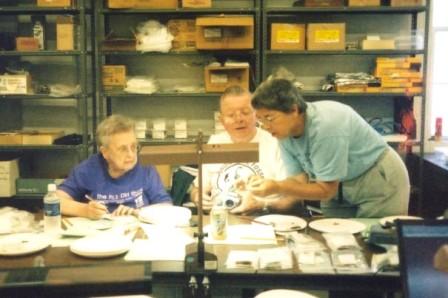Moss Lake - Passport in Time
Main menu:
Previous Projects > States M-R
Moss Lake Archeological Excavation
Chippewa National Forest, Minnesota, 2005-2006
By Andrea LeVasseur, Heritage Program Manager and Forest Archaeologist
The West Moss Lake site was first recorded in 2002 during reconnaissance survey of the area prior to a planned timber harvest. Sixteen positive shovel tests along the shoreline recovered ceramics, lithics, and faunal remains. The main occupation area appeared to extend northeast of the boat access as far as a small pond and it appeared to be a small, confined site, possibly representing occasional or small-scale use for limited activities.
In 2005 and 2006, The Chippewa National Forest evaluated the National Register eligibility of the site using Forest Heritage program personnel, Leech Lake Heritage Sites Program and Youth Conservation Corps crews, and volunteers in the Passport in Time program. A total of 58 square meters and seven additional shovel tests were excavated. The 2005 excavation focused on the shoreline area, but seven shovel tests produced some materials further inland on the lower terrace, as well as on a higher terrace further from the lake. The similarity to the South Pike Bay site occupation sequence and its relationship to landforms was noted, indeed, the upper terrace feature may be an extension of the landform found at South Pike Bay, which is located only about a mile north of Moss Lake. The following year, several new units were opened on the inland lower terrace, and on the upper terrace.
The topographic setting of the Moss Lake site clearly attracted Late Woodland people. It is located at the south end of the lake along a historic north-south travel route between the west side of Leech Lake and Cass Lake. It is also adjacent to a small wetland immediately to the west which would have been a part of Moss Lake if the lake surface elevation was about one meter higher. Given this favorable setting it is somewhat surprising that no trace of earlier Woodland components, particularly Brainerd, were recovered although this may be simply due to incomplete sampling.
Both the ceramics and projectile points recovered from the site indicate that the areas sampled thus far are almost exclusively Late Woodland. The purpose of the site other than as general habitation along a popular travel route is unknown. The poor preservation of faunal remains coupled with a lack of distinctive cultural features such as hearths is problematic. It is clear that many ceramic vessels were broken and many projectile points lost or discarded at the site. Lithic debris recovered indicates that people were mainly using and fixing their tools rather than making them from raw materials. Most of the lithic materials appear to have been derived form local sources. Trade or travel to the west is indicated, however, by the consistent presence of Knife River Flint, the source of which is in North Dakota.
The main occupation area and densest deposit lies in the shoreline area. The inland lower terrace contains a much more sparse deposit than the lakeshore. Based on ceramic assemblages, the lower terrace and shoreline appear to date from about 1200 years ago. The five square meters on the upper terrace produced ceramic materials in the shallow layers to about 45 cm (18 inches) depth. Below that, to a one meter depth, only lithic material was found. Although no diagnostic material was recovered, the lack of ceramics suggests a preceramic Archaic period age for these deposits that may date as early as 8000 years ago, as at the South Pike Bay site. The aceramic component located on the upper terrace also appears to reinforce the conclusion of the South Pike Bay analysis that older components are located on this topographic feature.
 (Photo: Margret and Donald Brazda and Gail Pyndus examine an interesting artifact during the 2005 laboratory session.)
(Photo: Margret and Donald Brazda and Gail Pyndus examine an interesting artifact during the 2005 laboratory session.)The excavations at Moss Lake have demonstrated that it is eligible for inclusion to the National Register of Historic Places because it is likely to yield important information regarding American Indian cultures prior to Euroamerican contact. The site has good physical integrity, abundant Late Woodland ceramics and future excavation with more detailed analysis would add to the understanding of Late Woodland cultures of the Mississippi Headwaters region.
Based on research and analysis, Moss Lake archeological site appears to meet National Register criteria and to maintain sufficient integrity. It is therefore eligible for listing in the National Register of Historic Places. The site would be considered a National Register eligible property under the Section 106 review process if a proposed undertaking calls for disturbance or alteration.